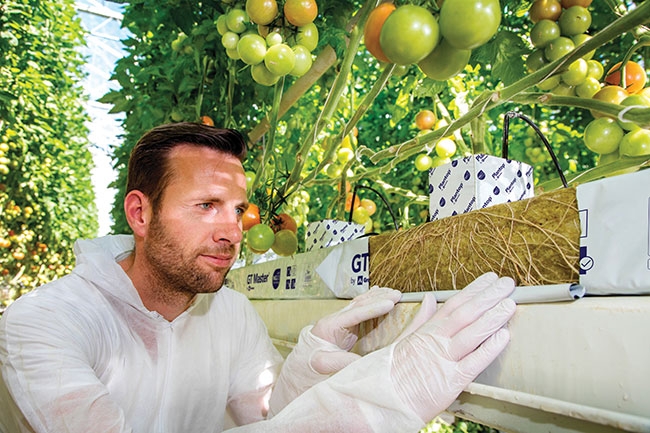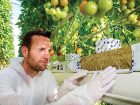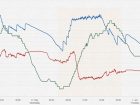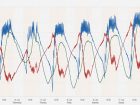
Features
Structures & Equipment
Water and irrigation
Managing the rootzone: Irrigation volumes and EC, WC graphs
A structured irrigation strategy can help optimize the crop’s rootzone and improve yields.
October 15, 2018 By Willem Gericke
 Irrigation strategies should consider multiple factors, including substrate volume, drain holes, irrigation volumes, crop phase, water content and electrical conductivity within the rockwool slab.
Irrigation strategies should consider multiple factors, including substrate volume, drain holes, irrigation volumes, crop phase, water content and electrical conductivity within the rockwool slab. In this article, we will focus on how to plan and execute a structured irrigation strategy, thus optimizing the rootzone, and consequently decreasing plant stress and potentially increasing yields.
There are a couple of factors to consider when planning an irrigation strategy. Grodan has devised the 6-Phase model for growing vegetable crops, a model where the growing period of a crop is divided into six phases. Phase 1 starts where the block is transplanted onto the slab, and Phase 6 ends when the last fruit is harvested. As most growers are currently in maximum production or Phase 5, we will interpret two different GroSens graphs which illustrate key points of interest. Note: GroSens measuring unit for WC is percentage.
Substrate volume
It all starts by having the right substrate volume. This is one critical factor, which can either have a vegetative or generative action on the crop. The ideal substrate volume for commercial vegetables is between 7.5 to 9.0 L/m2. When the substrate volume is on the lean side (less than 7.5 L/m2), it creates a more generative root zone, which forces the grower to increase the irrigation frequency, thus stimulating vegetative growth. During very generative growing conditions this approach is manageable, however, root health and fruit quality will be sacrificed during vegetative climatic conditions. Another problem is that the overnight dry back can become too severe during normal start and stop times, when using a small substrate volume. To counteract this, the grower must either start to irrigate earlier and stop later, or add a night cycle or two, which on the other hand can influence the plant’s physiology.
The opposite is also true. When the substrate volume is larger than 9.0 L/m2, it will result in plants growing vegetatively due to a small overnight dry back (3 to 5%). This makes steering the WC more difficult without using an extremely generative irrigation strategy (infrequent irrigation cycles). Therefore, root quality is compromised as well as nutrient refreshment.
Drain holes
Drain holes have a profound effect on WC (water content) and EC (electrical conductivity) management in the slabs. It is recommended, when used on gutters, that one to two drain holes are cut at the lowest point per 1.33 linear metre of a Grodan slab. It is advised that the drain holes are cut on the sides of the slab, approximately 2 to 3 cm from the edge of the rockwool. The cuts should be made from underneath the slab in an upward direction, and the foil must be opened, thus ensuring the efficiency of the drain holes. Opening the foil will ensure that the drain holes stay open, and the roots are air-pruned. When the slab is longer than 1.33 m, drain holes can be cut in the middle of the slab, but should never be made underneath a block. When this is done, the emitted water from the dripper will simply find the path of least resistance, causing false drain. Water content re-saturation and EC refreshment in the slab will be compromised, and there can be differences in WC and EC readings within the slab. When multiple blocks are used on a slab, and the distance between the blocks is limited, attention should be paid to the distance from the dripper in the block to the drain hole. The ideal distance from dripper to drain hole is 20 cm, and the dripper can simply be moved to the other side of a block, to increase the distance. This will have a beneficial effect on WC re-saturation and EC refreshment, and will also decrease variance within a slab.
Calculating irrigation volume
A structured irrigation strategy is necessary to generate a balanced plant, and can aid in counter steering a plant, as determined through crop registration. The first four to six irrigation cycles in the morning should range between 4 to 6% of the substrate volume, and is normally followed by irrigation cycles of 3% of the substrate volume. The following calculations will help to illustrate.
Determining slab volume:
Slab dimension: 100 cm x 20 cm x 7.5 cm = 15 000 mL or 15 L slab volume.
Blocks per slab: 4
Heads per block: 2
Plant density: 4.2
Drippers per slab: 6
Determining substrate volume per m2:
15 000 mL / (4 blocks x 2 heads)
= 1875 mL
1875 mL x (4.2 plant density) = 7875 mL or 7.875 L/m2 of substrate volume
Determining a 4% cycle:
7875 mL x (0.04) = 315 mL/m2
Determining the dripper density per m2
6 drippers / (4 blocks x 2 heads)
= 0.75
0.75 x (4.2 plant density) = 3.15 drippers/m2
(315 mL/m2) / (3.15 drippers/m2)
= 100 mL/dripper
The time needed to irrigate 100 mL/dripper when using a 2.2 L/hr dripper is determined as follows:
2200 mL (dripper) per 60 minutes (1 hour) = 36.67 mL/minute, thus:
(100 mL) / (36.67 mL/ minute) = 2.72 minutes or 163 seconds.
The same calculations apply when determining a smaller shot of 3% or a larger shot of 6%.
The varying cycle size of 4 to 6% is determined by a combination of factors which are influenced by the season, start and stop times and overnight dry back. Prominent differences between Fig 1 and Fig 2 will be touched on, emphasizing the key points to focus on, which will reduce plant stress and potentially generate a stable maximum production, which is generated through a structured irrigation strategy.
Water content profile
Any grower knows that when plant stress is reduced, a plant will function better. This can be accomplished through applying a structured irrigation strategy per plant growing phase in conjunction with the climate. The first thing to note when analyzing the WC (blue line) in Fig 1 is that there is no WC gradient decrease (purple square) just before the first morning irrigation cycles commence on the different days. This shows that the plants weren’t transpiring when the first irrigation cycle was given, potentially leading to active water uptake or as most growers refer to it, as increased root pressure, which can negatively influence plant physiology. Remember the golden rule, transpiration before irrigation!
Second is the fluctuating morning WC percentage over three days (grey line), varying between 60 and 68% before the morning cycles commence. This varying morning WC percentage creates plant stress that needs to be minimalized, and is determined by the irrigation start and stop times and overnight dry back. A late start and early stop time will generate a steep WC gradient, resulting in a big dry back (black square). In this scenario three night shots were given in Fig 1. to counteract the overnight dry back from becoming too severe, thus avoiding a too-low morning WC percentage. Night cycles are normally applied to compensate for incorrect start and stop times, thus limiting severe overnight WC decreases. It can also be necessary to give night cycles when the substrate volume is on the lean side, and the heating pipes are on, stimulating a generative growing climate and reducing the slab WC.
The morning cycle volume (4 to 6% of the substrate volume) is determined by the previous night’s dry back, and when the two days are compared it is evident that eight cycles were needed on May 31 vs the five cycles on June 1. If the eight cycles were reduced to five to six cycles while increasing the volume, drain would have been realized earlier and simultaneously increased the efficiency of EC control. The large morning cycles will re-saturate the WC in the slab and simultaneously refresh the EC. Also, the large morning cycles (between 4 to 6%) will ensure that drain is realized on time, thus reducing the EC (red line) before noon. It is advised that the irrigation cycles start two to three hours after sunrise and is big enough to realize drain at around 400 J/cm2 or around 600 W/m2, or four to five hours after sunrise. The small irrigation cycles observed in Fig 1. represent a nearly flat line, thus indicating very small dry backs between the cycles. To ensure that the oxygen levels in the slabs are replenished, the WC dry back percentage between the cycles must decrease between 1.5 to 2% before the next irrigation cycle is re-applied. Following this action will ensure that the rootzone stays active, during changing climatic conditions. Also, bear in mind that dissolved oxygen (DO) levels decrease with an increase in water temperature. The decreasing dissolved oxygen (DO) levels in the slabs have a profound negative effect on root formation. Newly formed roots are necessary to ensure the active uptake of water and nutrients – this emphasizes the importance of focusing on start and stop times as well as overnight dry back in conjunction with changing climatic conditions.
The first key point to focus on when interpreting Fig 2 is the steep WC decrease (between 1 to 2%) which occurs after dawn until the first irrigation cycle starts. Each day tends to have the same curved decrease in WC, and this clearly signifies that the plants were transpiring before irrigation started. It is a well-known fact that root hairs increase the root area and helps with water and nutrient absorption. Also, root hairs are actively initiated after sunrise until the first irrigation, and they are formed within hours. When there is little time from sunrise until first irrigation, root hair formation can be sacrificed. Therefore, it’s important to ensure that plants are actively transpiring before irrigation is activated. The starting WC percentage varies by only 2% over a seven-day period, which has a positive influence on rootzone management during the maximum production phase. This was accomplished despite the changing water temperature (green line) indicating a varying climate, and was achieved by focusing on the irrigation start and stop times and achieving a stable overnight dry back between 7 to 8%.
Although the number of morning irrigation cycles and water temperature (green line) differed between Thursday and Friday, the day dynamic WC percentage stayed stable between 64 to 65%, and it was achieved by changing the number and volume of irrigation cycles needed to reach the day dynamic WC percentage. Thus, the volume and number of irrigation cycles necessary to accomplish this was determined by the overnight WC decrease (dry back). An overnight dry back of between 8 to 10% is adequate to maintain an active rootzone. This is achieved by generating a 3% dry back over a three-hour period since the last irrigation ceased. It is clear to see that the irrigation morning volumes were large enough as the EC was reduced effectively before noon, and was stabilized during the rest of the irrigation cycles. This is paramount, as plant stress is severely reduced by having the lowest EC during the highest radiation. To achieve this, drain must start around 400 J/cm2 or at around 600 W/m2. Although, the irrigation cycles that followed the large morning cycles (blue line) were small, there was sufficient WC dry back between the cycles as the graph amplitudes varied around 1.5%, thus ensuring an oxygenated slab and maintaining an active rootzone during maximum production.
Takeaways
- Small and large substrate volumes influence the ability to control the WC and EC within the rootzone; small substrate volumes force vegetative irrigation strategies and vice versa
- The quantity and placement of drain holes per slab will influence the WC percentage steerability and EC refreshment within the slab
- Irrigation volume strategies are calculated per substrate volume which differs between growers, and large morning cycles between 4 to 6% of the substrate volume is used to re-saturate the WC and refresh the EC, while smaller 3% cycles are used in the afternoon to maintain the day WC and stabilize the EC
- Maximum production is enhanced by maintaining a stable day dynamic WC and the EC is controlled in a managed way through utilizing a structured irrigation strategy
Willem Gericke is a technical advisor at the Grodan Group. He recently submitted his MSc. thesis at Stellenbosch University, South Africa. Email him at willem.gericke@grodan.com
Print this page


